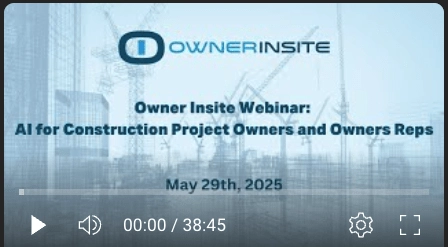A construction project is a complex undertaking, but while many people focus almost entirely on what happens before and during construction, the construction project life cycle extends long after all the contractors are gone and the closeout documents are signed and archived.
Several things continue to carry profound liability implications long after your construction project is completed, and health and safety is one of them. Let’s look closer at OSHA record-keeping rules for construction project Owners and how proper document control and ownership after completion can help you.
What Are OSHA Records?
Anyone who works on any building in the United States is subject to OSHA or the Occupational Safety and Health Act of 1970, which is managed Federally by the Occupational Safety and Health Administration.
The Occupational Safety and Health Act was created to formalize rules and regulations for safety on construction sites and workplaces. Over the years, it has evolved and expanded with many new laws and regulations falling under the umbrella of OSHA.
OSHA also protects both employees and the public. So, even if someone unrelated to a project or workplace suffers an injury or property damage, that would fall under the scope of that workplace or construction site’s OSHA obligations and records.
Of course, managing anything subject to so many regulations and legislation requires complex processes and procedures, and of course, those need to be documented. That’s where we get OSHA records from. They have recorded information from any construction project, including training, PPE issue records, incident and accident reports, and more.
Anything recorded on a construction site related to health and safety will form part of the OSHA records for that project.
Why Does OSHA Record-Keeping Matter?
OSHA record-keeping rules for construction project owners matter because health and safety is one of the elements of any construction project that can create liability months or even years or decades after a project has been finished.
That’s because OSHA covers workplace and job site injuries and accidents and relates to work-related illnesses, which might only appear long after a construction contract is completed.
Imagine, for example, that a construction worker was involved in a building project where they were accidentally exposed to asbestos. The effects of that exposure might only be seen many years after the project is completed. Still, someone would probably be liable for the effects of that exposure if proper precautions were not taken and regulations for handling asbestos were not followed.
Because OSHA’s responsibility extends to anyone involved in a project, everyone from the project owner to the site superintendents might be held responsible for that situation. This means that when there’s an investigation, everyone must provide documented proof that they met OSHA regulations related to their role.
Proper OSHA document retention and record keeping for project owners is critical to providing that proof.
What Are the OSHA Record-Keeping Regulations for Project Owners?
The exact OSHA record-keeping regulations you must comply with as a project owner will vary depending on your location. That is because some states manage their own OSHA plans, while some rely on Federal regulations.
States that have their own OSHA plans include Alaska, Washington, Oregon, California, Hawaii, Nevada, Utah, Arizona, New Mexico, Wyoming, Minnesota, Indiana, Illinois, Michigan, Iowa, Kentucky, Tennessee, South and North Carolina, Virginia, Maryland, New York, Vermont, Maine, Massachusetts, Connecticut, and New Jersey. Puerto Rico and the U.S. Virgin Islands also have regional OSHA plans that the Federal administration approves.
Some of those state and regional plans are also universally applied. In contrast, others might only apply to government workers, in which case you would revert to the Federal OSHA regulations for any other workers.
OSHA maintains an up-to-date list of States that have OSHA plans here, and you can see which procedures apply universally and only to government workers.
However, while there might be minor differences between the record-keeping requirements in some parts of the United States, most state plans meet or exceed Federal requirements. So, while you should still confirm the local conditions, they will likely be close to the Federal regulations.
These regulations usually include:
- Most employers with ten or more employees are required to record and maintain OSHA records
- Some industries are exempt, but since construction has a high risk of injury, it is not one of those
- Any severe workplace injuries or illnesses need to be recorded
- Minor injuries that are treated with first aid only do not need to be recorded
- Records must be kept for at least five years
- Every year, between February and April, employers have to report serious injuries they have recorded in the past year
- Employees and their representatives in any legal or regulatory action also have the right to request access to those records
You can also view the recordkeeping page on the OSHA website. There’s also more detailed information, including exemptions and industry-specific record-keeping requirements that are regularly updated, so bookmarking that page is a good idea.
Of course, these are only the minimum record-keeping requirements, and it’s a long way from minimum requirements to best practices in most cases.
Always remember that in the unfortunate event of a lawsuit brought by an employee on a project you were involved in, it may very well come down to the documentary evidence you can provide. So, it’s always a good idea to keep comprehensive health and safety records for every project and, ideally, to handle your health and safety planning with competent professionals on your construction team.
When it comes to OSHA litigation, sometimes it is just a matter of whether you dotted all the I’s, crossed all the t’s, and have the records to prove it.
Don't Rely on Others
Sometimes, construction project owners rely on third parties to manage their OSHA record-keeping and compliance. That might work during the active construction phase, but it’s a very risky strategy after completing the project.
Over time, companies might go out of business or change ownership. They might choose physical document storage solutions that are prone to compromise, and they might lose essential records by various means.
Since OSHA issues can arise years after your professional project team has moved on from your project, the safest option for OSHA record keeping for project owners is always to handle it in-house. If you already have the records you may someday need, you eliminate the step of trying to track them down if you do.
Owner Insite Makes Long-Term Data and Document Archiving a Priority
At Owner Insite, we’ve had years of experience in large-scale commercial and infrastructure construction projects, so we know just how critical good record-keeping can be before, during, and after any construction project.
That’s why we built industry-leading construction document archiving and storage tools into our system, which can include all your OSHA records.
So, if you’re wondering not only about the regulatory requirements of OSHA record-keeping for project owners but also how you will access that information if you ever need it, our team would love to talk.
Owner Insite provides a secure, easy-to-navigate digital construction document control system, so you can always find and access the correct OSHA documents when you need them most.
Contact Owner Insite to book a free demo, and let us show you how you can ensure that your OSHA record-keeping always meets and exceeds legal requirements.




